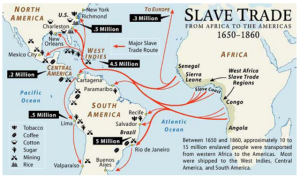Recognition of the Afromexican Population
By: Dr. Donají Mendez Tello, Universidad Autónoma de Guerrero, Founding Member and President of Mexico Negro, A.C.* (Translated by Patricia Ann Talley, Editor)
We are within the framework of the United Nations International Decade of Tribute People of African Descent (2015 – 2024). Back in December of 2017, I had to honor of attending a ceremony in Yanga, Veracruz, to unveil a plaque of declaration as a UNESCO world heritage site in memory of slavery and Afro-descendants in the Fort of San Juan de Ulua, the City of Yanga, and the state of Veracruz. I attended as a member of the Afro-Mexican Committee of the Universidad Autónoma de Guerrero.
Between 1650 and 1860, approximately 10 to 15 million enslaved people were transported from western Africa to the Americas. Most were shipped to the West Indies, Central America, and South America. (Source: Charles H. Wright Museum of African American History).
The African Presence in Mexico
Many people in the world and within Mexico are unaware of the African presence in the country. Enslaved Africans were brought to the country during the colonial era. Gonzalo Aguirre Beltrán, a pioneer of the study of black culture in Mexico and author of books such as Mexico’s Black Population, estimates that the Spanish brought more than 500,000 African slaves to Mexico.
The Afro-Mexican population in Mexico is concentrated in the states of Guerrero, Oaxaca, Baja California Norte, and Veracruz.
The City of Yanga, Veracruz is named after Yanga, who was one of the first black liberators in the Americas
In 1570, Yanga, who was an enslaved African prince, led a slave revolt in Veracruz and established the first free colony in the Americas.
I took photos in front of the statue of Yanga, one of the first black liberators in the Americas. The city of Yanga, Veracruz is named in his honor.
UNESCO in Mexico, as part and its International Slave Route Project, held a ceremony to unveil the plaque of the declaration as a world heritage site in memory of slavery and Afro-descendants in the Fort of San Juan de Ulua, the city of Yanga, and the state of Veracruz. The program was in coordination with the National Institute of Anthropology and History and its program of Afro-descendant and Cultural Diversity Research.
UNESCO, in coordination with Mexico’s National Institute of Anthropology and History, dedicate a plaque to honor this historical world heritage site as a major landing point in the African colonial slave route. Photography by Itzel Varela and Donají Mendez.
Maria Elisa Velázquez, the coordinator of the program, explained the importance of the historic memory sites of San Juan de Ulua and Yanga. The ceremony was attended by the Anthropologist Diego Prieto, General Director INAH; Leovigildo Da Costa E Silva, the Ambassador of Angola in Mexico, and Harry Grappa Guzmán, Secretary of Tourism of Veracruz, among other personalities.
In my participation, I proposed and demanded a museum that narrates the history of the Afro-descendant population in our country.
I proposed and asked for a national museum that narrates the history of the Afro-descendant population. This museum should be integrated into other historical memory sites such as the Museo Fuerte de San Diego, located in the Port of Acapulco.
With this proposal, we will continue with the diversification of the cultural tourism offered in the state of Guerrero, as well as studies on the subject in the Costa Grande region of Guerrero. Guerrero is noted for its population of Afro-Mexicans, who are concentrated in the Costa Chica region of the state.
I thank Dr. Gabriela Iturralde and her team and Dr. Javier Saldaña Almazan, Dean of UAGro, who has integrated scholarships for Afro-Mexicans, the first university with this program. I also thank David Franco Garcia Orozco, Coordinator of Costa Grande, Blanca Estela Leyva Gutierrez, Director of UAGro Zihuatanejo, and Mexico Negro, A.C. This project of recognition started over 20 years ago.
I am proud to be Afromexicana!
About the Author: Professor Méndez Tello is an instructor at Universidad Autónoma de Guerrero in Zihuatanejo, Guerrero. She is an expert in African-Mexican history and a co-founder and President of Mexico Negro, A.C., (Black Mexican Civic Association).



